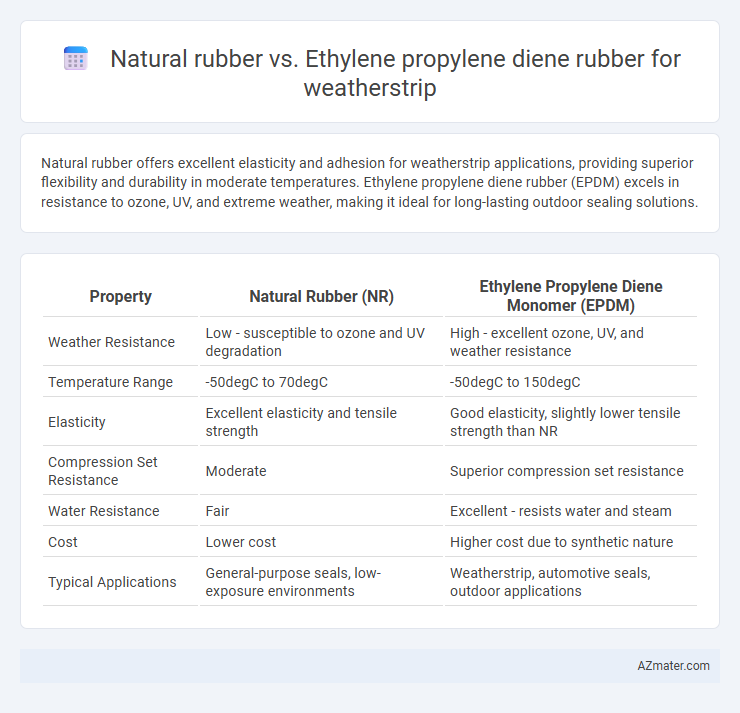Natural rubber offers excellent elasticity and adhesion for weatherstrip applications, providing superior flexibility and durability in moderate temperatures. Ethylene propylene diene rubber (EPDM) excels in resistance to ozone, UV, and extreme weather, making it ideal for long-lasting outdoor sealing solutions.
Table of Comparison
| Property | Natural Rubber (NR) | Ethylene Propylene Diene Monomer (EPDM) |
|---|---|---|
| Weather Resistance | Low - susceptible to ozone and UV degradation | High - excellent ozone, UV, and weather resistance |
| Temperature Range | -50degC to 70degC | -50degC to 150degC |
| Elasticity | Excellent elasticity and tensile strength | Good elasticity, slightly lower tensile strength than NR |
| Compression Set Resistance | Moderate | Superior compression set resistance |
| Water Resistance | Fair | Excellent - resists water and steam |
| Cost | Lower cost | Higher cost due to synthetic nature |
| Typical Applications | General-purpose seals, low-exposure environments | Weatherstrip, automotive seals, outdoor applications |
Introduction to Weatherstrip Materials
Weatherstrips require materials with excellent elasticity, weather resistance, and durability to prevent air, water, and dust infiltration. Natural rubber offers superior resilience and flexibility, making it ideal for applications requiring tight sealing and flexibility in varying temperatures. Ethylene propylene diene monomer (EPDM) rubber provides outstanding resistance to ozone, UV rays, and extreme weather conditions, making it highly suitable for long-term outdoor weatherstripping applications.
Overview of Natural Rubber (NR)
Natural Rubber (NR) is a highly elastic elastomer derived from the latex of Hevea brasiliensis trees, offering excellent tensile strength, flexibility, and resilience. In weatherstrip applications, NR provides superior sealing properties, abrasion resistance, and good performance in dynamic conditions but is less resistant to ozone, UV, and chemical exposure compared to synthetic alternatives like Ethylene Propylene Diene Monomer (EPDM). Its biodegradability and natural origin make NR a preferred choice for eco-friendly products requiring high durability and elasticity in moderate environmental conditions.
Overview of Ethylene Propylene Diene Rubber (EPDM)
Ethylene Propylene Diene Rubber (EPDM) is a synthetic elastomer widely used in weatherstripping due to its exceptional resistance to ozone, UV radiation, and extreme weather conditions, outperforming natural rubber in durability and longevity. EPDM's superior flexibility and excellent aging properties make it ideal for sealing applications exposed to outdoor elements, maintaining elasticity over a broad temperature range from -40degC to 150degC. In comparison to natural rubber, EPDM offers enhanced chemical resistance and lower maintenance requirements, making it the preferred choice for automotive and architectural weatherseals.
Physical and Mechanical Properties Comparison
Natural rubber exhibits superior tensile strength and elasticity compared to Ethylene Propylene Diene Monomer (EPDM) rubber, offering excellent resilience and flexibility in weatherstrip applications. EPDM features enhanced resistance to ozone, UV radiation, and extreme temperatures, maintaining mechanical integrity over prolonged outdoor exposure. While natural rubber excels in abrasion resistance and tear strength, EPDM provides better aging stability and compression set resistance, ensuring long-term sealing performance in diverse climates.
Weather Resistance: NR vs EPDM
Ethylene Propylene Diene Monomer (EPDM) exhibits superior weather resistance compared to Natural Rubber (NR), making it ideal for weatherstrip applications exposed to UV rays, ozone, and extreme temperatures. EPDM maintains elasticity and durability across a wide temperature range (-40degC to 150degC), while Natural Rubber degrades rapidly when exposed to sunlight and ozone. This increased stability of EPDM ensures longer service life and reduced maintenance costs in outdoor sealing solutions.
Durability and Longevity in Outdoor Environments
Natural rubber offers excellent flexibility and resilience but tends to degrade faster in outdoor environments due to exposure to UV radiation, ozone, and extreme temperatures. Ethylene propylene diene monomer (EPDM) rubber exhibits superior weather resistance, maintaining durability and elasticity under prolonged sun exposure, ozone, and temperature fluctuations, making it highly suitable for weatherstrip applications. EPDM's enhanced longevity and resistance to environmental stressors ensure better performance and reduced maintenance in outdoor sealing solutions.
Cost Considerations and Market Availability
Natural rubber offers a cost-effective option for weatherstrip applications due to its lower raw material price and widespread production, making it readily available in global markets. Ethylene propylene diene rubber (EPDM) typically incurs higher costs because of its complex manufacturing process and specialized properties, but its superior weather resistance justifies the premium in long-term use. Market availability for natural rubber remains stable with established supply chains, while EPDM supply is more concentrated among specific chemical manufacturers, potentially affecting lead times and pricing fluctuations.
Environmental Impact and Sustainability Factors
Natural rubber, derived from renewable latex sap of rubber trees, offers superior biodegradability and a smaller carbon footprint compared to synthetic Ethylene Propylene Diene Monomer (EPDM) rubber, which relies on petrochemical sources. EPDM provides exceptional resistance to ozone, UV radiation, and weathering, resulting in longer lifespan and reduced replacement frequency, factors contributing to lower environmental impact over time. Sustainable production of natural rubber involves responsible forestry practices and fair trade initiatives, whereas advancements in recycling technologies for EPDM aim to mitigate its synthetic polymer waste challenges.
Application Suitability for Weatherstrips
Natural rubber offers superior elasticity and excellent compression set resistance, making it highly suitable for weatherstrips that require tight sealing and flexibility under varying temperatures. Ethylene propylene diene rubber (EPDM) excels in ozone, UV, and weather resistance, ensuring long-term durability for outdoor and automotive weatherstripping applications exposed to harsh environmental conditions. EPDM's superior resistance to heat, aging, and ozone outperforms natural rubber, making it the preferred choice for weatherstrips in extreme climates and prolonged outdoor use.
Conclusion: Choosing the Right Rubber for Weatherstripping
Natural rubber offers excellent elasticity and tackiness, making it ideal for weatherstripping applications requiring superior sealing and flexibility in moderate climates. Ethylene propylene diene monomer (EPDM) rubber provides exceptional resistance to UV rays, ozone, heat, and weathering, ensuring long-lasting performance in harsh environmental conditions. Selecting the right rubber depends on the specific demands of the weatherstrip application, with natural rubber favored for indoor or mild-weather uses and EPDM preferred for external or extreme weather exposure.

Infographic: Natural rubber vs Ethylene propylene diene rubber for Weatherstrip
 azmater.com
azmater.com